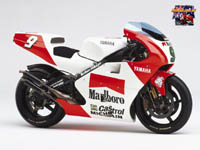
OWJ1 (1996) – Adoption of a 54mm bore piston The major new feature of the OWJ1 spec YZR500 introduced in 1996 was the new engine with a 54mm bore. By squaring off the bore x stroke at 54mm x 54mm, compared to the previous 56mm x 50.6mm, this engine succeeded in boosting top speed through a better balance of power and torque character based on total intake/exhaust efficiency rather than simply raising rpm. This model was also characterized by its forged “powder metal” piston with excellent heat resistance qualities and a new frame design that eliminated the seat rail. Riding this machine, Norick Abe shaved an amazing two seconds off the fastest lap time at the Japan GP preliminaries and went on to win the race for his first GP victory. Loris Capirossi also won a round this year on the OWJ1 at the Australian GP.
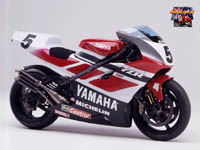 OWH0 (1997) – V bank widened to 75 degrees On the OWH0 spec introduced in 1997, the “V” bank of the engine was widened from 70 to 75 degrees in order to allow an increased air box capacity. A “T” type exhaust port (conventional three-port to two-port) known for its excellent pick-up characteristics was also tested on this model, along with adoption of a new crank assembly spec and a higher drive shaft position for improved handling stability. On this machine Cadalora mounted the winners podium twice with second place finishes and twice with third place to finished the season ranked sixth, while Abe ranked seventh.
OWH0 (1997) – V bank widened to 75 degrees On the OWH0 spec introduced in 1997, the “V” bank of the engine was widened from 70 to 75 degrees in order to allow an increased air box capacity. A “T” type exhaust port (conventional three-port to two-port) known for its excellent pick-up characteristics was also tested on this model, along with adoption of a new crank assembly spec and a higher drive shaft position for improved handling stability. On this machine Cadalora mounted the winners podium twice with second place finishes and twice with third place to finished the season ranked sixth, while Abe ranked seventh.
(The OWH0 and OWJ1 were actually developed simultaneously and their eventual years of actual GP use happened to come in reverse of the alphabetical order of their code names.)
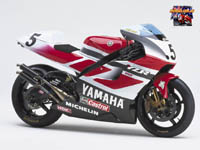 Abe’s 1998 OWK1 OWK1 (1998-99) – Non-leaded arrives The 1998 YZR500 (OWK1) was a non-leaded gasoline spec in line with the revised GP regulation. The combined effect of improvements including revised compression ratio, new muffler shape, change to a Keihin carburettor (previous models used Mikuni), reduction of crankcase power loss and boosted cooling capacity served to achieve outstanding performance. Also the angle of the engine’s V bank was returned to 70 degrees. Despite the non-leaded spec, this machine produced course records on many of the GP courses. Ridden by Jean-Michel Bayle, Norick Abe, Simon Crafar and Regis Laconi, the machine continued to mature through the season, with Crafar winning his first GP race on it at the British GP.
Abe’s 1998 OWK1 OWK1 (1998-99) – Non-leaded arrives The 1998 YZR500 (OWK1) was a non-leaded gasoline spec in line with the revised GP regulation. The combined effect of improvements including revised compression ratio, new muffler shape, change to a Keihin carburettor (previous models used Mikuni), reduction of crankcase power loss and boosted cooling capacity served to achieve outstanding performance. Also the angle of the engine’s V bank was returned to 70 degrees. Despite the non-leaded spec, this machine produced course records on many of the GP courses. Ridden by Jean-Michel Bayle, Norick Abe, Simon Crafar and Regis Laconi, the machine continued to mature through the season, with Crafar winning his first GP race on it at the British GP.
In ’99, Max Biaggi and Carlos Checa joined the Yamaha riders and the OWK1 continued to mature, with Biaggi, Abe and Laconi each winning one round this year. On Biaggi’s machine, wings were added on the right and left sides of the front cowl in mid-season to improve road contact feeling for the front wheel, but due to the problem of balance with the down-force characteristics during full banking on turns, they were removed again in the latter half of the season. OWK6 (2000)- Yamaha’s ninth manufacturers title The OWK6 model of 2000 was a further evolution of the OWK1 of the previous year and it achieved higher levels of acceleration and top speed performance due to improvements including new cylinder, cylinder head and exhaust pipe specs and revision of several parts of the performa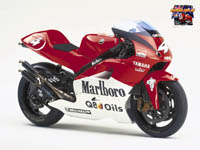 nce-boosting engine management system. Also review of the dimensions and geometry led to a new cowl shape. With Garry McCoy’s three wins, Biaggi’s two and Abe’s one, this machine brought Yamaha its ninth manufacturers championship after a seven-year hiatus.
nce-boosting engine management system. Also review of the dimensions and geometry led to a new cowl shape. With Garry McCoy’s three wins, Biaggi’s two and Abe’s one, this machine brought Yamaha its ninth manufacturers championship after a seven-year hiatus.
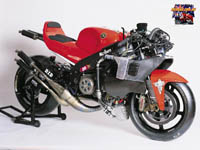 OWL6 (2001)- Biaggi second in championship The OWL6 spec of 2001 took the existing model as its base and added revisions relating to driveability including new cylinder, cylinder head and exhaust pipe specs, changes in the performance characteristics of the YPVS system and mapped ignition timing control that contributed to increased acceleration and top speed performance. Revisions in the dimensions also added to the pick-up coming out of the turns. This model also featured long and short type rear arm options to fit the characteristics of the different riders. Biaggi scored three wins this year to place second in the season ranking.
OWL6 (2001)- Biaggi second in championship The OWL6 spec of 2001 took the existing model as its base and added revisions relating to driveability including new cylinder, cylinder head and exhaust pipe specs, changes in the performance characteristics of the YPVS system and mapped ignition timing control that contributed to increased acceleration and top speed performance. Revisions in the dimensions also added to the pick-up coming out of the turns. This model also featured long and short type rear arm options to fit the characteristics of the different riders. Biaggi scored three wins this year to place second in the season ranking.
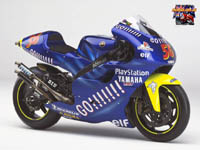 OWL9 (2002)- The 28th and last generation YZR500 Of all the YZR500 models that had actually competed in GP races since its debut in 1973, the OWL9 that appeared in 2002 represented the 28th and last generation model. The engine was positioned farther forward than that of the OWL6 of the previous year while the centre of gravity was also raised slightly in order to secure the desired front weight distribution. Weight was reduced through full-fledged thinning efforts on the rear arm. In this year’s GP regulation that had two-stroke and four-stroke machines competing together, the great competitive potential of the YZR500 was proven once again when Olivier Jacque won the pole position at the German GP on this machine and Abe finished the season ranked sixth.
OWL9 (2002)- The 28th and last generation YZR500 Of all the YZR500 models that had actually competed in GP races since its debut in 1973, the OWL9 that appeared in 2002 represented the 28th and last generation model. The engine was positioned farther forward than that of the OWL6 of the previous year while the centre of gravity was also raised slightly in order to secure the desired front weight distribution. Weight was reduced through full-fledged thinning efforts on the rear arm. In this year’s GP regulation that had two-stroke and four-stroke machines competing together, the great competitive potential of the YZR500 was proven once again when Olivier Jacque won the pole position at the German GP on this machine and Abe finished the season ranked sixth.























